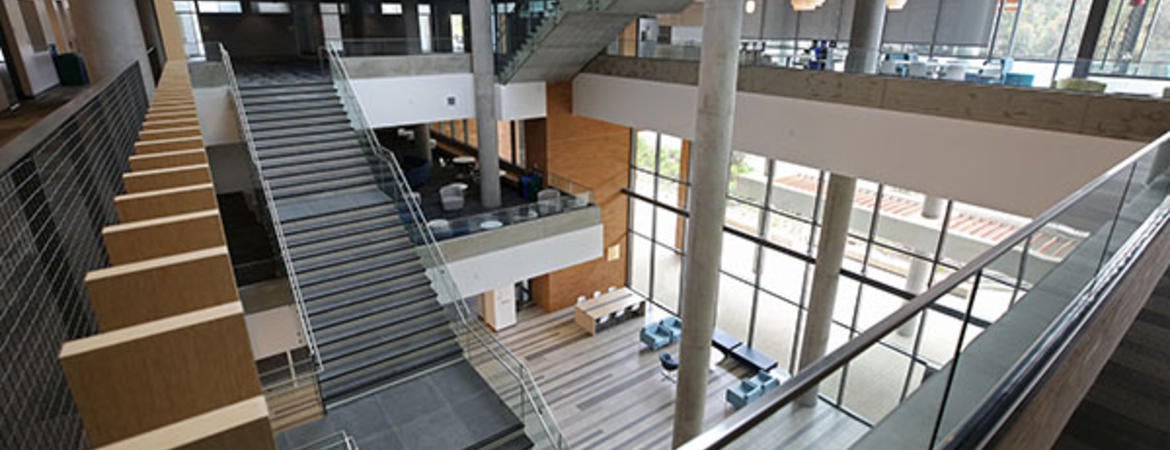
UC Riverside is celebrating the completion of the $150 million Multidisciplinary Research Building, or MRB, which will provide an innovative and collaborative approach to conducting research.
Campus leaders held a dedication ceremony Friday for the five-story, 179,000-square-foot building that now stands as the largest and most sophisticated research facility on campus. Located on 2 acres near the intersection of Aberdeen and North Campus drives, the project took three-and-half years to complete.
Chancellor Kim A. Wilcox said the MRB positions the campus on the cutting edge of research.
“We envision this as a place where scientists from all over the world can come, share research, talk about their work, and plan for the future,” he said.
State Senator Richard Roth, Assemblymembers Jose Medina and Sabrina Cervantes, Riverside Mayor Rusty Bailey, and Riverside Councilman Andy Melendrez joined staff, faculty, and students for the ribbon-cutting celebration held in the atrium of the building. Afterwards, faculty and students who will be working there provided tours.
The new building increases research space on campus by 9 percent — bringing the total amount to just over 1 million square feet. It’s part of an expansion of research space over the last decade that includes the 2016 opening of the Advanced Neuroimaging building, the Material Science and Engineering building in 2011, and the School of Medicine Research building in 2010.
In a first for UCR, the building was designed so research teams from different fields of science can share laboratory space and work collaboratively on solving problems using different approaches, said Jacqueline Norman, campus architect.
“There’s no other building like this on campus in what it can do and how it can serve the researchers,” she said.
For instance, the building features large, open lab bays where teams from the chemistry department could work alongside those from the School of Medicine. That open atmosphere is reflected throughout the facility with amenities such as communal sitting areas where researchers can gather informally.
Teams won’t be divided by floors, but clustered into different areas interspersed throughout the building to encourage cross-pollination of ideas, Norman said.
“It is a real boost for UCR’s research enterprise,” UCR Provost Cynthia K. Larive said. “It’s going to encourage new science, new research, and new technology that we wouldn’t have been able to affect in our siloed environments.”
The building makes extensive use of natural light with a four-story atrium and skylight at the entrance and large windows with striking views of Mount Rubidoux and the Box Springs Mountains.
The exterior features UCR brick from a local quarry that reflects the colors of the outside landscape. Other design elements include metal panels, concrete panels and siding, and terra cotta screens over the glass.
“The architecture is contemporary and representative of its time and use of the building,” Norman said. “It feels a part of UCR by use of the brick — it connects with the campus.”
The building will house 56 faculty investigators and their teams researching areas such as life sciences, chemical sciences, medicine, and engineering.
Among those excited to move into MRB is the Food, Bugs, Guts & Brains team, which includes microbiologists studying bacteria and microbes that reside in the gut and impact diet, disease, and behavior.
“The nature of our research is very multidisciplinary, which is the whole purpose of MRB,” said Frances Sladek, a professor of cell biology. “Our group looks at interactions between the microbes in the gut and the host, and ultimately how those interactions impact host physiology and behavior, especially with regards to the brain. There are many neuroscientists moving into the MRB, so it will be great to have that expertise on hand.”
Sladek said her team expects to move into MRB during the spring quarter.
Other teams selected to work at MRB are Imaging; the Data Science Center; the Environmental Toxicology Group; the Interdisciplinary Center for Quantitative Modeling in Biology; Mind & Brain health: Neuroinflammation, Neurotrauma and Neurodegeneration; Systems Biology of Infectious Disease; and Molecular, Circuit and Behavioral Mechanisms of Neurodevelopmental Disorders.
The eight teams will move into the building over the course of the year, Norman said.
Peter Hickmott, a professor of psychology and a member of the Neurodevelopmental Disorders team, said while he and other neuroscientists already work together, the new building will make it easier for them to do so.
“It’s going to be a good-size critical mass of neuroscientists in the building,” Hickmott said. “I’m excited to move in.”
MRB represents two other milestones for the campus: It’s the first major “design-build” project and first LEED Platinum-certified project. Design-build is a streamlined process in which one company handles both aspects of the project. LEED stands for Leadership in Energy and Environmental Design, a certification developed by the U.S. Green Building Council for energy-efficient buildings, with Platinum the highest of four levels.
“It is a grand and beautiful building,” Norman said. “It is a magnificent addition to our UCR campus.”
MRB
Inside the new Multidisciplinary Research Building on Thursday, Dec. 20, 2018. (UCR/Stan Lim).
×